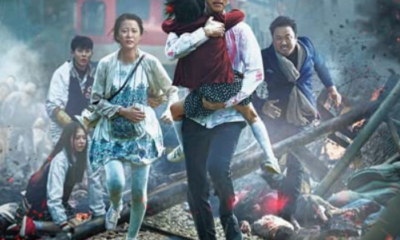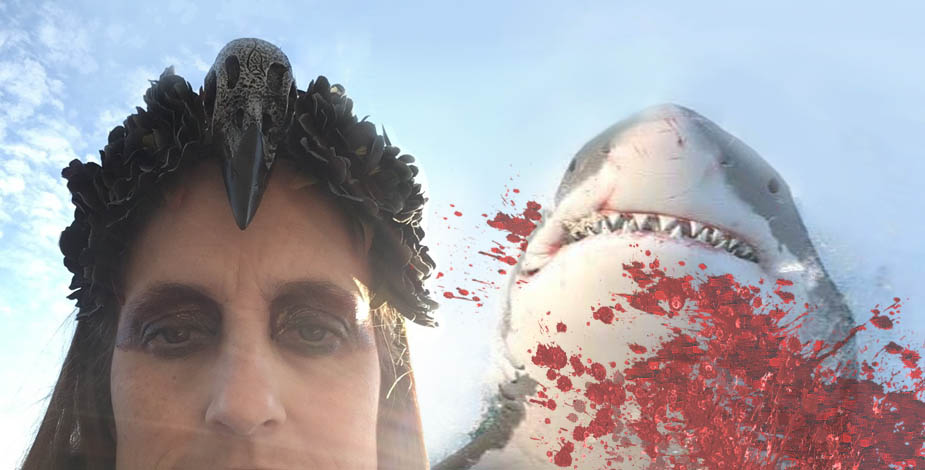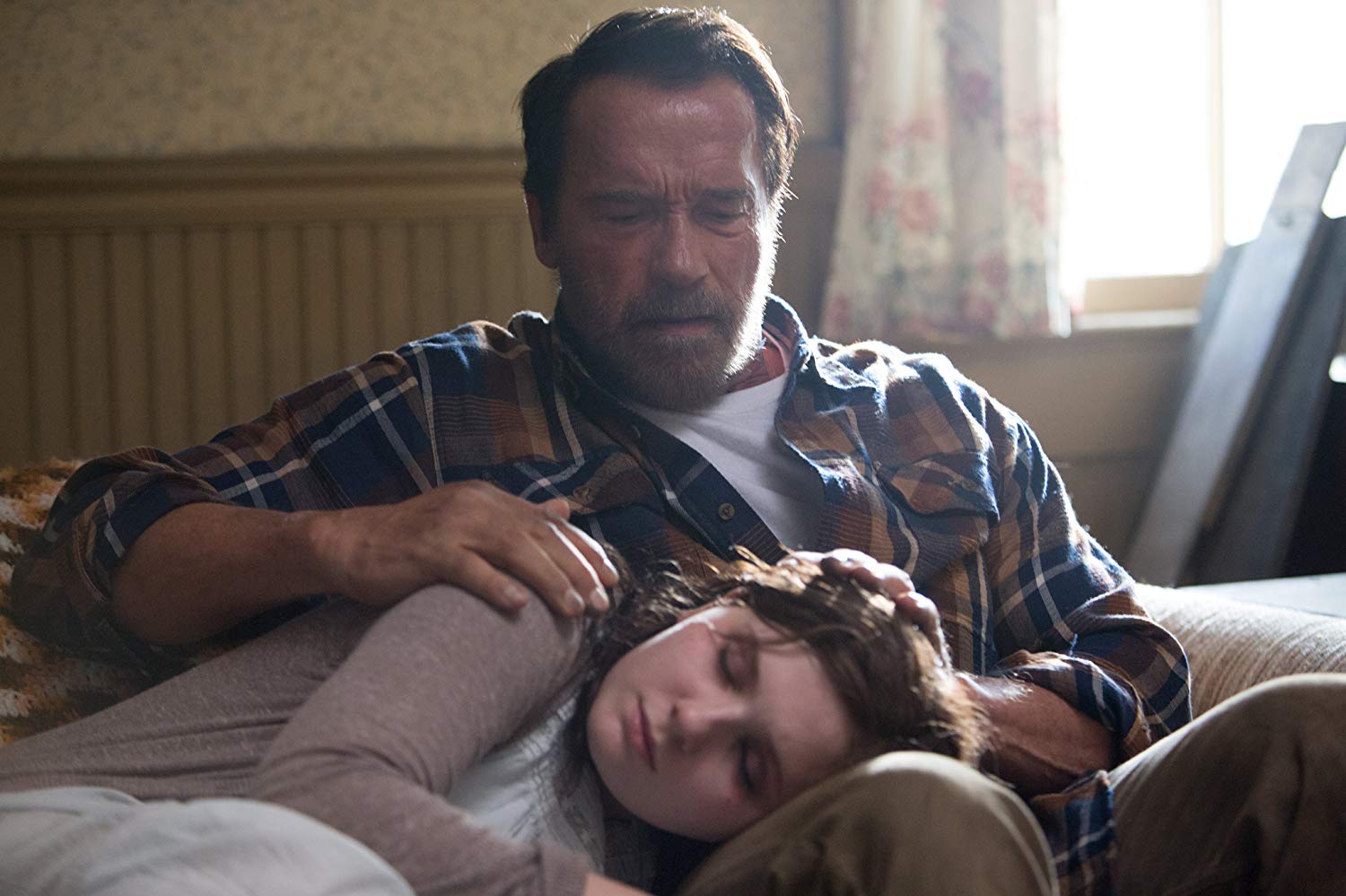
Review: 2015’s “Maggie” is a Midwestern Drama with Zombies
More Videos
Published
4 years agoon
By
J.M. Brannyk
I think that one of the reasons that people find the zombie genre is so popular is because it’s so relatable. In every point of history, there has been a very legitimate fear of infection, and of becoming part of a huge mass of the unidentified/unnamed/unclaimed waste left in its aftermath. It’s a terrifying thought to have to watch your body rot and decay into something inhuman before your own eyed. Just as there’s a complex horror of being swallowed into an unmarked mass grave, full of other rotting husks of unknown strangers.
And of course, the more bureaucratic nightmare of quarantine – the loss of control over one’s freedom, autonomy and body. The isolation of being a number in a system, a statistic to be glossed over in news reports, or worse, totally neglected by the system built to serve and protect you as a citizen.
At the time of this review, the world is rocked by the Corona virus. Clips of videos and pictures on the internet show people being removed in hazmat protection, portions of cities blocked off for quarantine, and countless people reacting to fake or real bouts of public sickness. Borders have been closed. PPE has been sold out completely online.
Before that was Ebola, H1N1, SARS, Bird Flu, Hantavirus, The Spanish Flu, Tuberculosis, Rabies, Leprosy, The Black Death…
And, something more akin to this movie – the HIV/AIDS epidemic. But before we get into all that…
The Plot:
Maggie, played by Abigail Breslin, has just been given a death sentence – she’s been bitten by an infected person and is now positive for a disease that’s been ravaging the entire US. After trying to run away, she is picked up by her father and taken back to their house in the quiet countryside to await her fate. She’s given only a few weeks to spend with her family before being forced to suffer her final days isolated in quarantine.
During her time at home, she must come to accept her mother’s past death, learn to forgive, and face her mortality while losing her agency and body in the process as she becomes sicker. She experiences the fear and ignorance of even her closest loved ones as she becomes less and less of Maggie and more of something else entirely…
The non-spoiler reveal:
There’s no way around this: Arnold Schwarzenegger plays her dad.

It’s…unfortunate and, frankly, jarring to see older Arnold play a Midwestern farmer and father to a young twenty-something (and father to even younger children). And it’s not to say that he doesn’t try in this film, because he does.
And he does a good job at acting, but what probably drew a lot of people to watch this movie (me included) was what ended up hurting it – it’s an Arnold Schwarzenegger zombie movie at the end of the day. No matter how it’s packaged, that’s what’s going to stick in people’s minds and when this slow-burn drama starts unfolding, it’s…well…

(snob glasses affixed) In “Genre And The Invention Of The Writer”, especially when examining Foucault’s “author-function”, Anis S. Bawarshi said:
“The author-function does not refer to the ‘real’ writer, the individual with the proper name who precedes and exists independently of the work. Instead, it refers to the author’s name, which, in addition to being a proper name, is also a literary name, a name that exists only in relation to the work associated with it. The author-function, then, endows a work with a certain cultural status and value. At the same time, the author-function also endows the idea of ‘author’ with a certain cultural status and value.” https://www.jstor.org/stable/j.ctt46nxp6.5
“The author-function delimits what works we recognize as valuable and how we interpret them at the same time as it accords the status of author to certain writers” https://www.jstor.org/stable/j.ctt46nxp6.5
I know, you’re thinking, ‘But Brannyk, doesn’t that work in favor of the movie? The reason that we’re talking about the movie right now is because of Arnold “Put That Cookie Down” Schwarzenegger? And also, what happened with the HIV/AIDS talk?’
We’ll get to HIV/AIDS in a minute. First, yes, Arnold and Abigail Breslin’s (but we know it’s Arnold) capital is what drew people in. In fact, that reliance on his capital was incredibly faulty direction that the marketing took – relying on (and exaggerating) the scarce action scenes of the movie. They even went as far as to hype the movie with the most ridiculous tagline: “Don’t Get Bitten” as a way to sell Action-Arnold, and not Midwestern old-dad Arnold.

It’s no wonder that, while it fared well with critics, it bombed hard, not even making back its budget (which probably mostly went to the salaries for the actors, as there was limited effects and locations).
And it’s a shame because “Maggie” is a fresh take on an old trope. And so, patient reader, we get to HIV/AIDS.
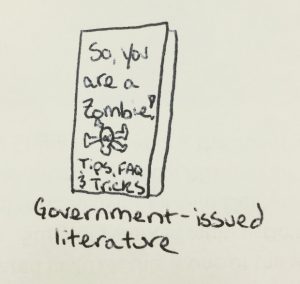
Brain Roll Juice:
“Maggie” is not the total chaos and calamity of most zombie outbreak movies. It’s an epidemic, yes, but as we see government-issued brochures given to Maggie, as we hear NPR news reports, and boring, routine doctor visits – this is not a collapsing society situation. Yet, there’s fear and prejudice against those infected. There’s ignorance. Some of it is rational – they are living in the country, where everyone knows everyone and resources are reserved for the larger cities. Maggie is seen as a victim, a carrier, a ticking time-bomb, a troublemaker, and an innocent child.
During her own time of accepting her virus and fate, friends and loved ones try understand how this change will affect them – some say goodbye, some turn away, and some give into prejudice and ignorance.
Throughout the movie (whether intentional or not) the interactions with the community, the government’s awkward involvements, and the sickness itself (not the cannibalistic part, though, duh) is reminiscent of the HIV/AIDS epidemic of the 80’s-90’s. Maggie as a “carrier” of a deadly and mysteriously disease that is clumsily handled by government officials and little understood by the general public pulls a lot from history. We see Maggie losing agency, little by little, with her choices and her own body as she is slowly succumbing to the virus. We see more government intervention by way of law enforcement and medical staff, even when trying to help her. We see her own friends misunderstand her and the community at the brink of hysteria.
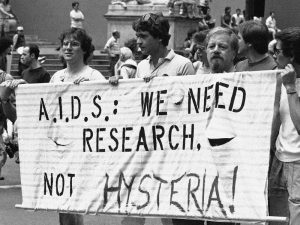
In fact, when questioned about the school re-opening and asked whether he would send his child to school with a child with the disease, the mayor of the town had this to say,
“I’m glad I’m not faced with that problem today, and I can well understand the plight of the parents and how they feel about it. I also have compassion, as I think we all do, for the child that has this and doesn’t know and can’t have it explained to him why somehow he is now an outcast and can no longer associate with his playmates and schoolmates. On the other hand, I can understand the problem of the parents. It is true that some medical sources had said that this cannot be communicated in any way other than the ones we already know and which would not involve a child being in the school. And yet medicine has not come forth unequivocally and said, ‘This we know for a fact, that it is safe.’ And until they do, I think we just have to do the best we can with this problem. I can understand both sides of it.”
Just kidding. That was Reagan in ’85. A full two years before forming the President’s Commission on the HIV Epidemic in ’87. And that was after AIDS was named in ’82 and HIV identified in ’82.
Any who, what I’m getting at is that there are similarities that make this a familiar ride in an old trope that I found refreshing, surprisingly rewarding and genuine. While I hope this nod was deliberate, the zombie virus itself pays homage to very real and very deadly diseases in our world as I stated before and while the scary zombie move is fun, this was a good stroll into what other facets the zombie genre could tell. Familiar stories. Heartbreaking stories. Vulnerable stories of communities trying to recover and survive; families learning how to deal with loss and say goodbye; and victims finding agency (in small or big ways) within their suffering and their final moments.

Bottom-line:
A slow drama with Arnold Schwarzenegger and zombies. If you feel like you’re up to that, give it a go.
 (3 / 5)
(3 / 5)
When not ravaging through the wilds of Detroit with Jellybeans the Cat, J.M. Brannyk (a.k.a. Boxhuman) reviews mostly supernatural and slasher films from the 70's-90's and is dubiously HauntedMTL's Voice of Reason. Aside from writing, Brannyk dips into the podcasts, and is the composer of many of HauntedMTL's podcast themes.

You may like
Movies n TV
Bodies Bodies Bodies (2022), a Film Review
Bodies Bodies Bodies (2022) is a horror comedy directed by Halina Reijn. This R-rated horror film stars Amandla Stenberg and Maria Bakalova.
Published
2 days agoon
April 29, 2024
Bodies Bodies Bodies (2022) is a horror comedy directed by Halina Reijn. This R-rated horror film stars Amandla Stenberg, Maria Bakalova, Myha’la, Rachel Sennott, Chase Sui Wonders, Pete Davidson, Lee Pace, and Conner O’Malley. The film is currently available on fuboTV, Netflix, Hoopla, and Showtime.
Sophie (Amandla Stenberg) brings her girlfriend (Maria Bakalova as Bee) to her friend’s hurricane party. Lasting resentment and toxic relationships infest the group, leaving Bee to witness increasingly uncomfortable situations. Soon after, bodies start dropping.
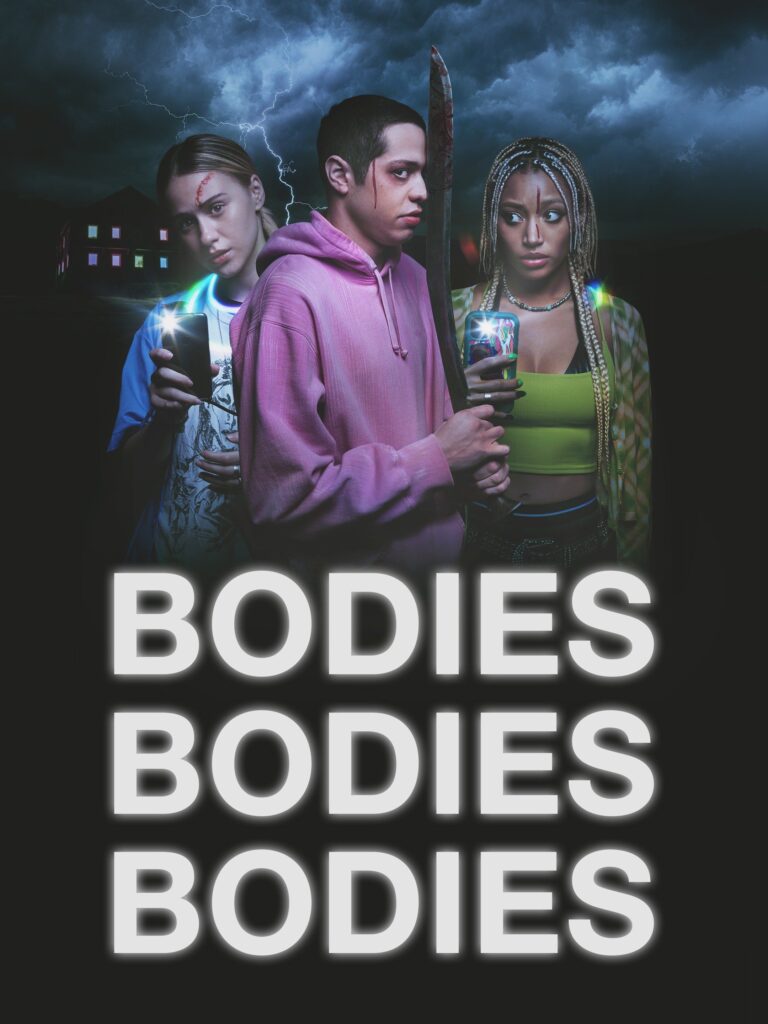
What I Like about Bodies
The chemistry between these toxic friends gives me anxiety. If toxic friendships aren’t a universal experience, toxic traits certainly make themselves apparent in any friend group, and this film maximizes this experience. It’s not revolutionary, but effective and uncomfortable.
Several subtle clues hint at the relationships of these friends, building up as the story progresses and chaos ensues. I love these moments, though the film doesn’t seem confident that the viewer picks up these clues. This decision hinders execution, an unfortunate point for later.
While the performances are strong throughout, Amandla Stenberg and Maria Bakalova remain the main characters and receive the most opportunities to perform. However, almost every character has a moment, or several, and lives up to those moments once given.
The twist seems obvious, but that doesn’t hinder the viewing experience. While not the biggest fan of the execution, I enjoy the spiraling chaos it creates.
The opening scene shows the two leads making out for viewer engagement. However, I think the contract toward the end gives this scene added context and plot relevance beyond simply sex appeal. While it is unavoidable that so well, many films will go no further. So, added relevance deserves a nod.
Far from the bloodiest film out there, but it doesn’t hesitate to bleed its cast. It uses this blood and limited gore to add weight to the deaths as opposed to haunting or nauseating its audience.

Tropes, Triggers, and Considerations
As previously hinted, toxic relationships remain key points in the plot. Falling in line with this are points of spousal abuse (physically and mentally) that should remain a consideration.
Idiocy to push the plot along certainly plays a role in the plot. In this case, I consider it a feature. However, it’s still a required taste for viewer consideration.
Addiction and recovery drive several characters. I’ll avoid pointing to them so as not to give away plot details. However, usage and relapse deserve a mention in this section.
If any of these are deal breakers, give this film a skip.

What I Dislike, or Food for Thought, about Bodies
Bodies shifts between a mindless and clever horror comedy, never comfortably sticking to one or the other. It pulls off elements of both with expertise, but the tugging and pulling of these different elements limits the execution of either. Because of the above friction, Halina Reijin gives us all the clues to piece everything together and still tells us. Pick an audience and trust them.
As a horror comedy, this film leans on the humor over the horror. The unraveling of characters certainly earns respect but expect a comedy for a better experience. It’s not a particularly scary film, and it doesn’t try to occupy that space.

Final Thoughts
Bodies Bodies Bodies spirals into a chaotic horror comedy, banking on the toxic chemistry of its cast to deliver both. The film never makes a strong stance in either claiming a mindless or clever horror comedy, shifting between both at the expense of the whole. It remains a bumpy but engaging viewing experience, nonetheless. (3 / 5)
(3 / 5)
Episode four of Amazon Prime’s Fallout was a great one for character development. It was also great because one of my personal favorite actors was involved.
Let’s discuss.
The story
This episode’s story revolved largely around Lucy and The Ghoul. He’s still dragging her about on a rope, but we aren’t sure why. While she can track the Head, she certainly hasn’t shared that information with the Ghoul.
What he wants her for soon becomes clear, when he barters her for vials of the medication that keeps him from losing himself to the ghoul illness.
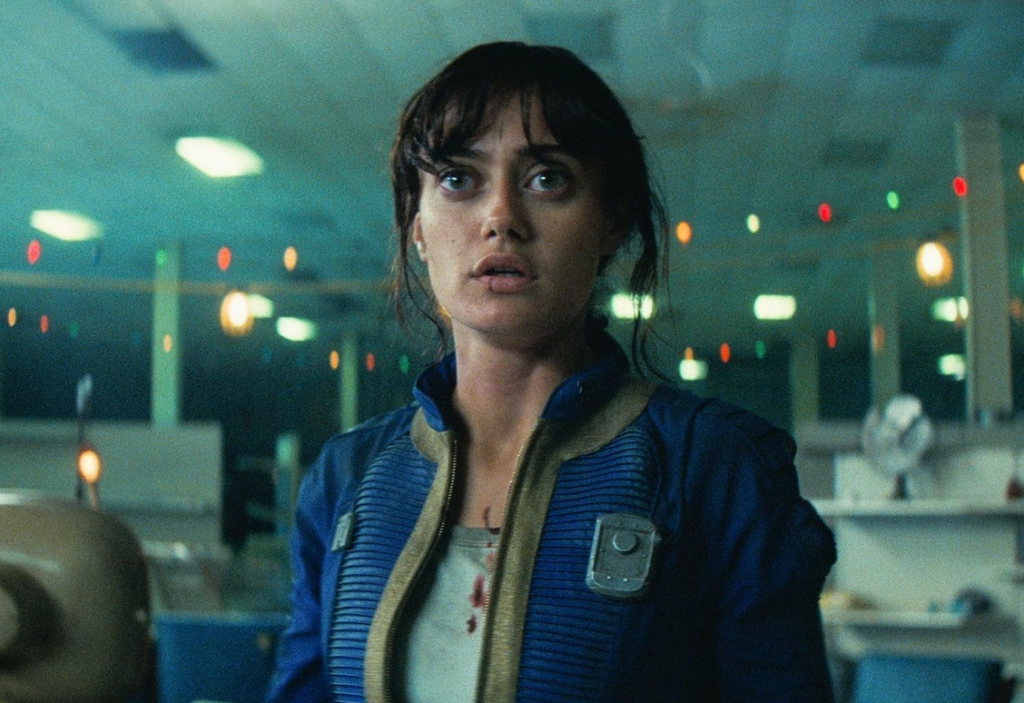
At first, Lucy thinks this is a step up. She’s taken by a robot surgeon named Snip Snip to get a new thumb. Since, you know, The Ghoul shot her thumb off.
However, after stitching a new thumb on, Snip Snip takes her to his masters. Who then say they want him to cut her up for her organs.
Lucy manages to escape and even frees the other people trapped by these organ brokers. In doing so, she comes into the possession of many, many of those vials that The Ghoul needs so desperately.
Meanwhile, Norm is starting to suspect that all is not what it should be in Vault 33. While the rest of the vault is preparing to elect a new overseer, he takes Chet and sneaks off to Vault 32. There, they find some horrific sights. Long dead bodies, next to messages scrawled in blood. There are especially bodies around the door that leads to Vault 31, where someone has written We Know What’s in There on the wall.
Of course, we don’t know what’s in there. But I’m sure we’re going to find out.
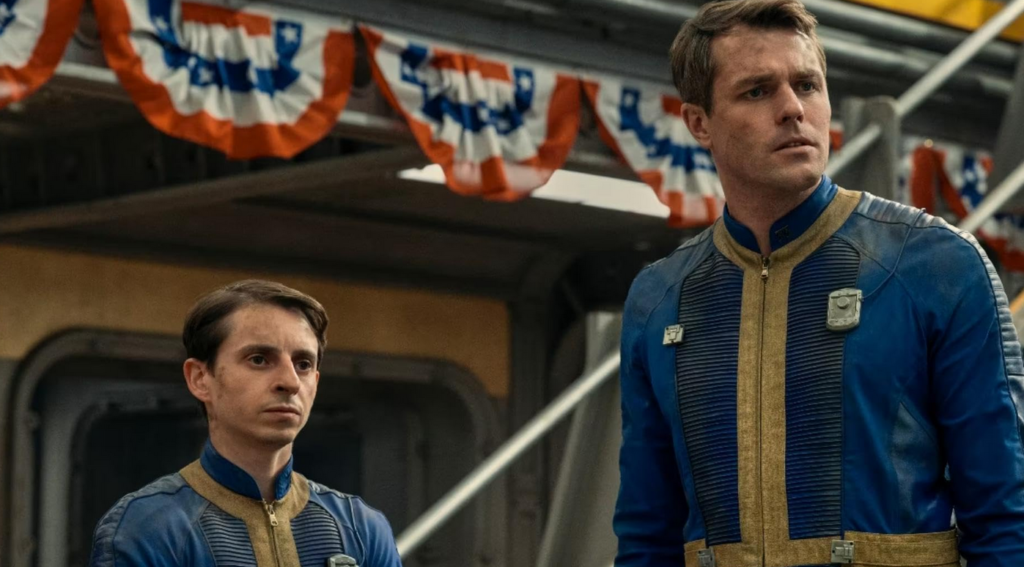
Norm continues to dig, checking for information on the old Overseer’s computer. And he finds that the door to Vault 32 was opened by a Pip-Boy. To be specific, it was a Pip-Boy owned by Norm and Lucy’s mother.
I’m sure that won’t be relevant later.
What worked
The more I see of this season, the more I like Lucy. She is growing and evolving as a person, just like Wilzig told her she would have to do. She is becoming harder. But her kindness and values haven’t changed yet. She is still a good person. I love that.
I also love the dark, creepy storyline with Norm. I love how serious he is, especially when compared to the rest of his community. I especially love that, even as emotionally disturbed he is by what he’s learning, he seems passionate. And from what we’ve seen of this character, this is possibly the first thing he’s felt passionate about his entire life. I am impressed with the writing and acting that have allowed us to see his lack of passion with minimal focus. He is a fun, well-written character.
Finally, I’d like to shine the spotlight on Matt Berry. He is a delightful actor known for What We Do in the Shadows and IT Crowd. And he is playing the remarkably funny role of Snip Snip, the robot surgeon. His voice lends an extra level of humor to an already funny premise. This was another example of the great casting we’ve seen so far on Fallout.
In the end, this was a great episode from all points. It was fun, heartfelt, and dark. In short, I have no notes. I’m only excited to see what happens in the next episode.
 (4 / 5)
(4 / 5)
The finale of American Horror Story Delicate aired last night. And if you were watching along with us on Threads, then you already know that it didn’t live up to any of my expectations.
Let’s discuss.
The story
We begin with Anna being ushered off stage and into an ambulance. Dex is there because Siobhan called him.
Once in the ambulance, though, the blood starts to spill. And it’s not just Anna’s. She soon finds herself in the clutches of the coven, giving birth in the most anxiety-inducing place possible. And when the baby is born, he’s taken away at once.
Because that’s the agreement that Anna made, without fully realizing what she was agreeing to.
If Anna’s going to get her baby back, she’s going to have to make another sacrifice. She is going to have to join the coven herself. Is she strong enough to do it? Is she strong enough to raise a monster?
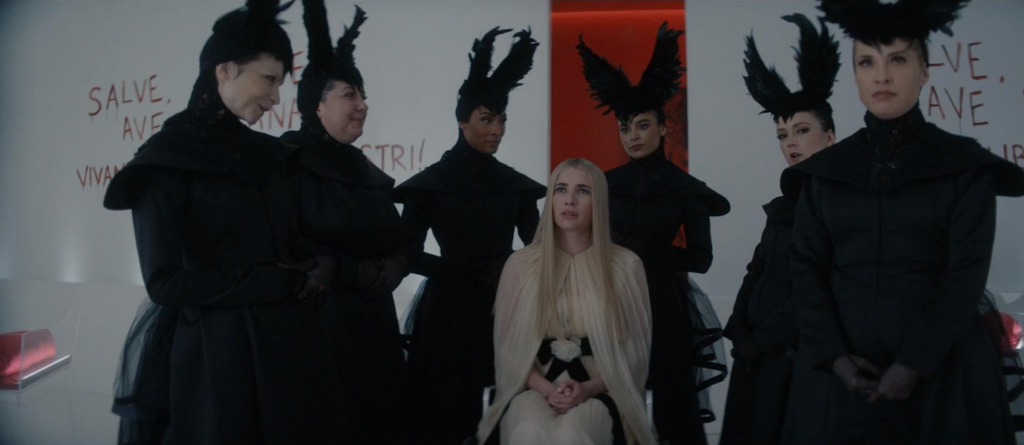
What worked
This episode did have some fun elements. As a practicing witch myself, I appreciate the addition of Hestia in a positive light. Especially when this season was so focused on motherhood, womanhood, and sisterhood, Hestia was a lovely goddess to include.
For those who don’t know, Hestia is a goddess of the home and hearth, but not a maternal goddess. She was, in fact, a virgin goddess. So Adeline’s devotion to her made sense in a real-world witchcraft way. Adeline was supposed to be a symbol of female love and support. Including Hestia in this made that crystal clear.
This was made most clear with the behavior of Siobhan. She was a perfect example of a toxic person who uses sisterhood to use and manipulate others. This can be seen clearly in the flashback that begins this episode. We see Siobhan show kindness to Anna, who she wants to use while being cruel to the woman who shared her story at the start of the meeting. For Siobhan, kindness is a currency she spends to get something. And that is clear.
What didn’t work
Sadly, those two elements weren’t enough to save this episode. My first concern is that this ending had more holes in it than Swiss cheese.
This wasn’t just a matter of having questions left after the ending. These were elements that we should have seen and just didn’t. Why were the witches diluting and working with blood near the end of the episode? Why didn’t Dex Senior get what was coming to him? What the hell was with those pointed green heels? My largest question, however, is this.
Did Anna imagine all of this? Did any of it happen? We don’t know. Consider the ending. I don’t want to spoil too much of this, so I’ll only point out Anna’s gown. It’s bloody in one scene and newly clean the next. This is only the example I can share without spoiling the ending. But we have no proof that any of these things happened to her.
While it’s fine to leave some questions up to the viewer, there were too many here. Rather than feeling mysterious, it just felt incomplete. And seeing as how this episode was much shorter than a standard one, this could have easily been corrected.
I would also like to hold some space for how this season ruined the good message of the book Delicate Condition. This novel was bloody, gory, and disturbing. But it also had a beautiful message about sisterhood, and women supporting women through motherhood, career choices, and life in general. There is so much pure, sisterly love in that book.
This is entirely missing from this season. It’s often turned on its head, with women betraying each other for their own selfish desires. And honestly, I hated that.
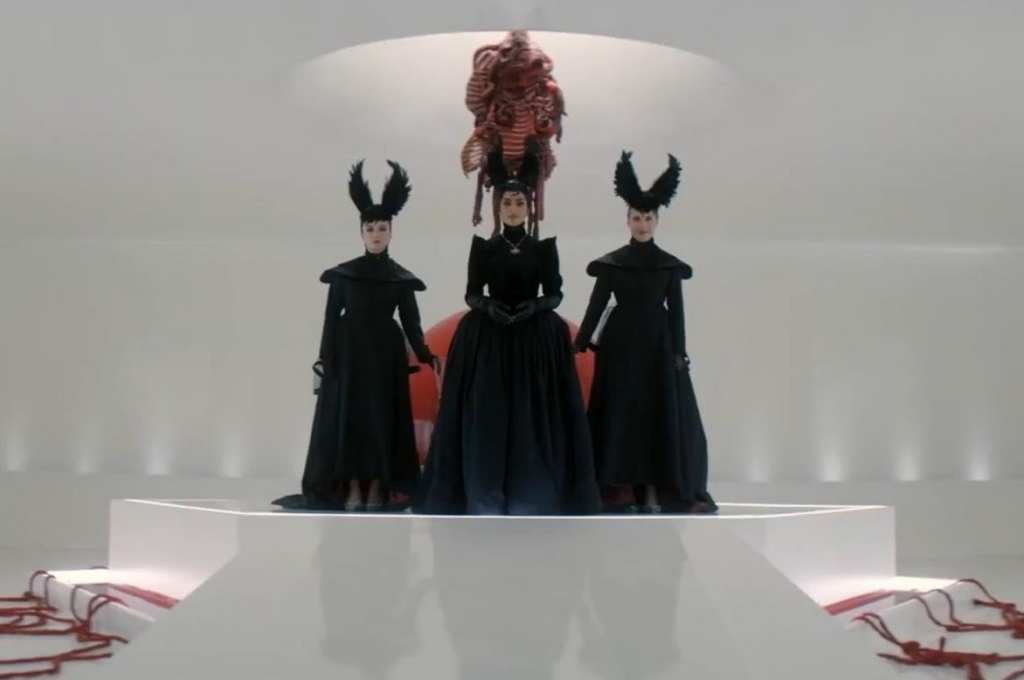
Finally, this season finale is another example of an ending ruining a good season. AHS Delicate wasn’t without its charm. Some episodes were great fun. There were elements that I truly enjoyed as a horror fan, a witch and a woman. But this ending just soured everything good about the season. It spoiled all of the enjoyment I had. Much like Sabrina, Dexter, and the podcast Dolores Roach, the ending ruined everything that came before it.
In the end, this finale was disappointing. It didn’t deliver on its promises, it did a disservice to the source material, and it was poorly executed. This series is more than capable of better. Delicate Condition, the novel, deserved a better interpretation.
However, as a long-time fan, I can honestly say that in twelve years of content, I have genuinely disliked a season and a half of American Horror Story. This one, and the second half of Double Feature. So while AHS Delicate was a disappointment, I am looking forward to season thirteen. In the meantime, I’m going to rewatch Coven and look forward to better stories to come.
 (2 / 5)
(2 / 5)





